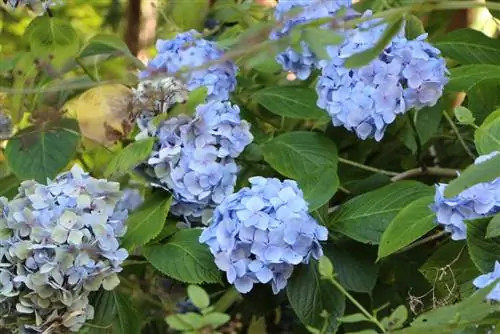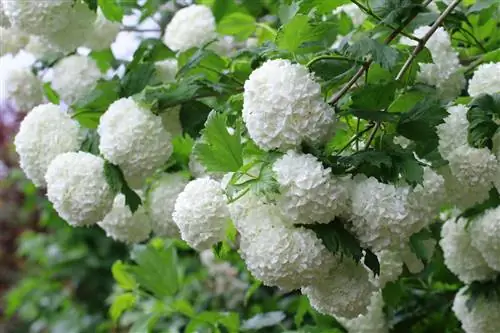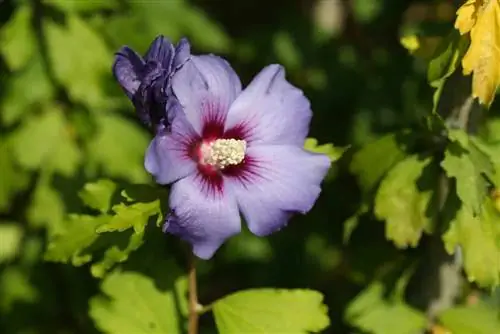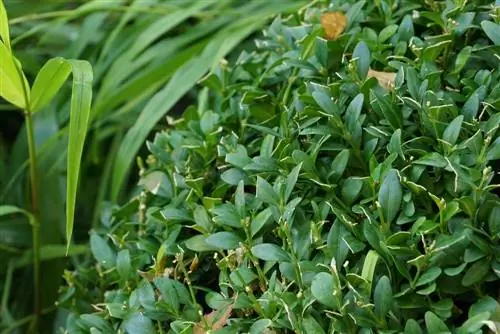- Author admin [email protected].
- Public 2023-12-17 03:39.
- Last modified 2025-01-24 12:45.
Hortensias are old, traditional cottage garden plants and can now be found in almost every garden due to their variety of species and varieties. They are undemanding, easy to care for, bloom readily and will delight us for many years as they can grow very old.
Garden hydrangea
In particular, this species, also known as the ball hydrangea or farmer's hydrangea, is well-known and popular. Even if it is not definitely winter hardy, its size varies from 60 to 300 cm, depending on the variety, and it can find a place everywhere. It is therefore not surprising that newer varieties are mainly bred from this species.
Endless Summer®
One of these new breeds is the Endless Summer®. It grows to a height of 100 to 120 cm and, in keeping with its name (in German: endless summer), continually produces pink flower balls throughout the summer and into autumn.
A variation of the classic Endless Summer® in pink is the `Bride, which delights with snow-white flowers.
Unusually for this species, this variety is considered to be particularly frost hardy down to -30 °C. It also impresses with its compact growth and particularly dense foliage with large, medium green leaves.
Flowers
But it has even more to offer, because it is the only variety of garden hydrangea that blooms in the same year, even after pruning. It also forms its flower balls on very young shoots, not just on older wood like other garden hydrangeas.
In the first year it produces 15 to 20 cm large flower balls and continually forms new buds in the summer, which bloom in the same year. Removing wilted inflorescences additionally stimulates them to form new buds.
Her endurance is also special. It blooms continuously throughout the summer, while other garden hydrangeas usually take a short break from blooming. It is also known for its enormous abundance of flowers.
The last flowers should remain on the plant over the winter, because even when dried they are an ornament and protect the buds directly underneath from too much cold.
Care
Hydrangeas have high nutrient and water requirements. From the moment the first leaves form, they should be supplied with a special hydrangea fertilizer every four weeks.
The plant needs a lot of water, the soil should not dry out in summer. But do not water over the flowers.
Floor
As with all hydrangeas, the variety loves acidic soil. However, it is robust enough to cope with normal garden soil. Unlike many other hydrangea species, it is also lime-tolerant.
If the soil is calcareous, the Endless Summer® blooms pink; if the soil is acidic, the flowers turn blue. This can be achieved by adding a special fertilizer for blue hydrangea flowers. It should be given to the plant in alternation with normal fertilizer, i.e. every 8 weeks.
Location
Hydrangeas like a sunny to partially shaded location, preferably a little protected from cold wind. A semi-shady spot where the plant gets sun in the morning or evening is ideal; The hot midday sun is not tolerated well.
The Endless Summer® variety can also be kept excellently in a pot. However, since it needs a lot of water and nutrients, special care must be taken to ensure a constant supply, especially in the bucket. The pot should not be too small and if growth is normal, it makes sense to repot it about every two years. With this plant, as with most others, you should not wait until the soil in the pot has completely rooted, as in this case, of course, not much water and nutrients can be stored in the missing soil.
pruning
Pruning is not necessary for garden hydrangeas, and Endless Summer® does not require one either. However, it is very easy to cut if necessary and, in contrast to other varieties of this species, it also produces flowers on annual shoots, not just on two-year-old shoots. Therefore, even after pruning, it blooms the same year.
In some cases the growth can be somewhat sprawling, where it makes sense to shorten the shoots a little. It then usually grows a little bushier. In addition, disturbing shoots can also be removed.
Due to the large and therefore heavy flower balls, some overly long, thin shoots are occasionally unable to hold the weight on their own and sink. If you don't want to support it, you can use pruning shears to shorten it to where the shoot becomes thicker.
It is best not to cut young, newly planted plants at all. For the first few years it makes most sense to limit pruning to slight corrections to the shape and only after about 5 to 6 years can proper pruning be carried out if necessary. It is best to remove a third of all main shoots for thinning, namely the oldest ones and those that grow too densely.
Even if the Endless Summer® is considered to be particularly hardy, pruning in early spring after the late frosts is preferable. If necessary, it can also be cut back in autumn, but then some, especially new and thin shoots, can freeze.






